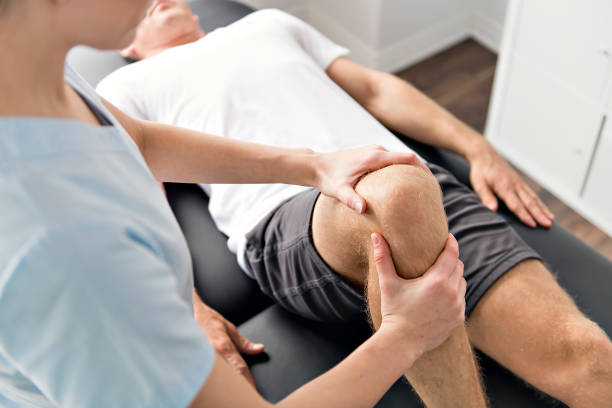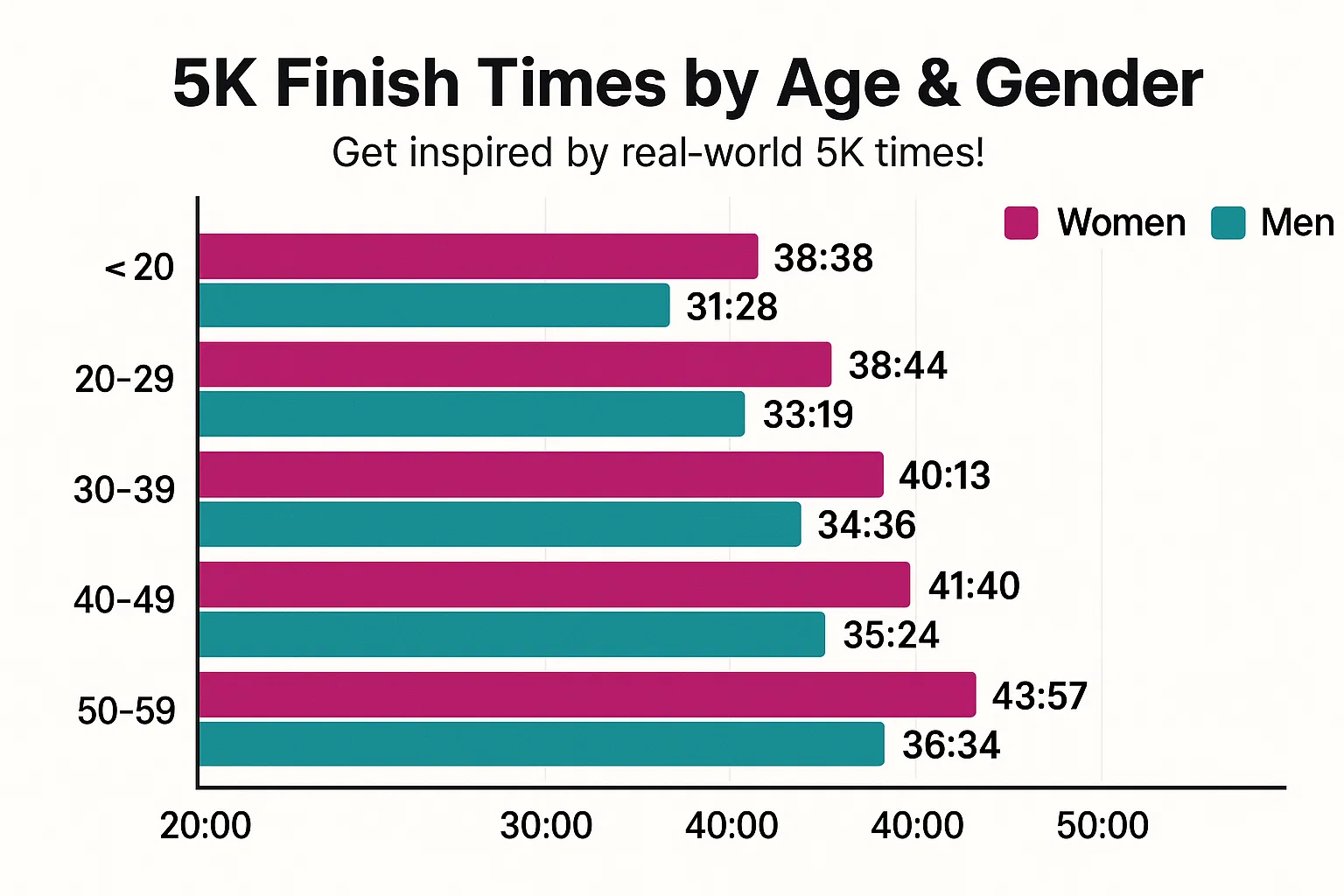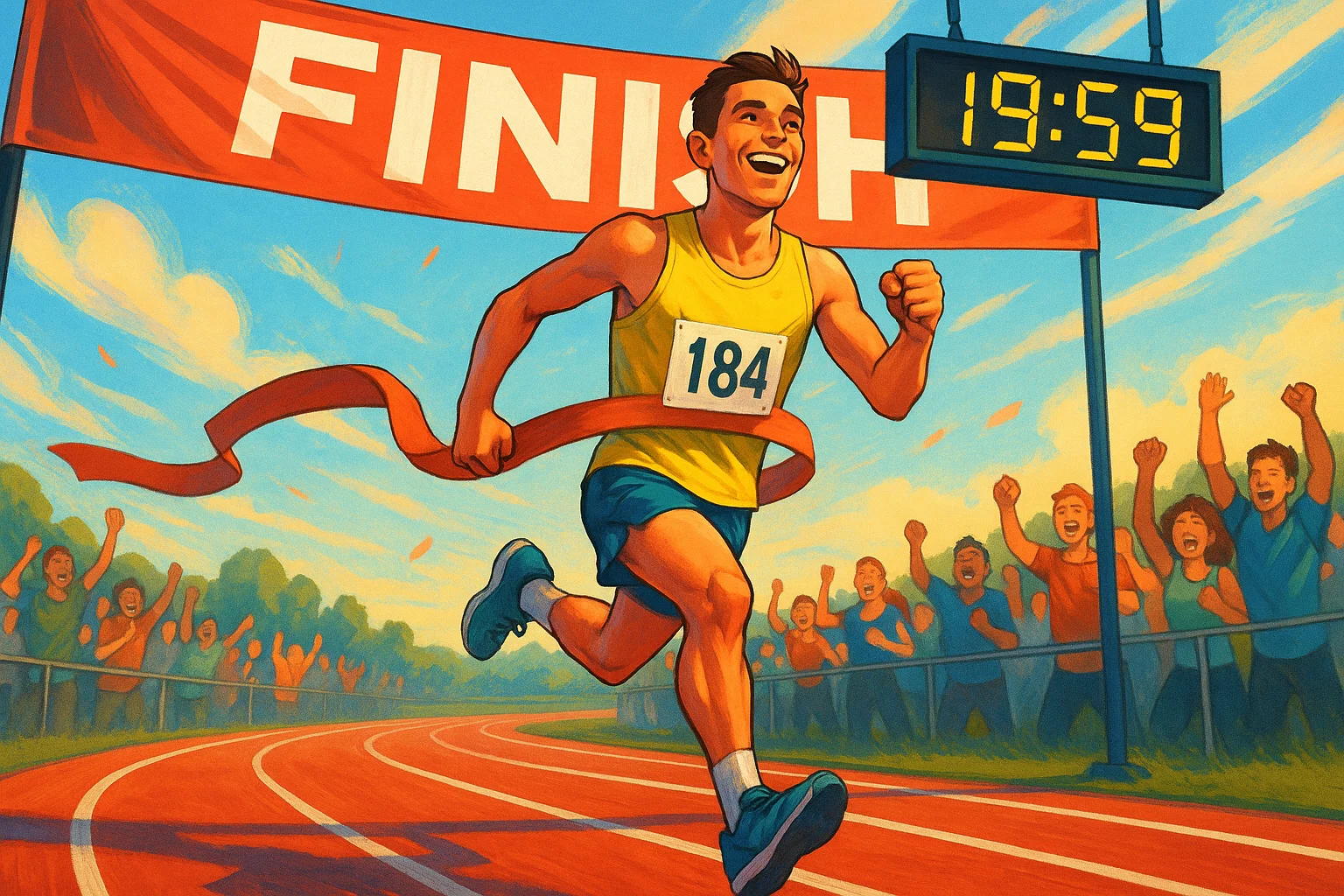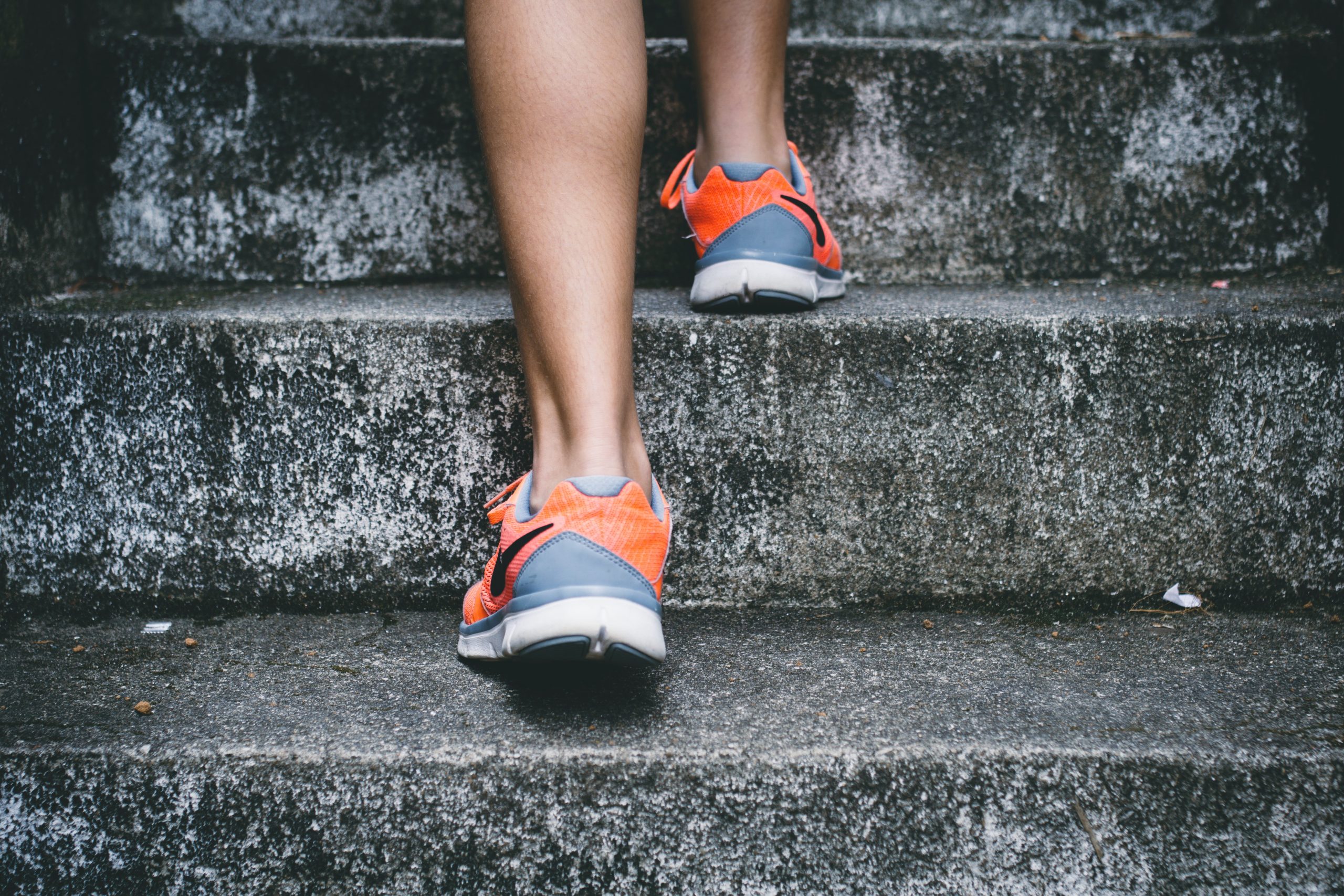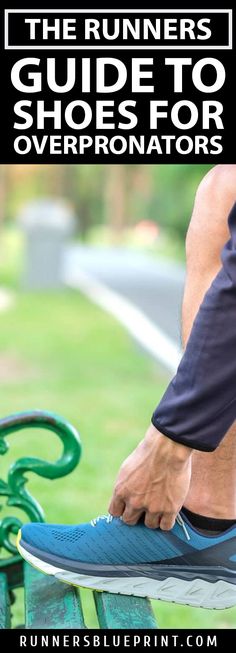I see you. You’re here, diving headfirst into the world of running, ready to seize the countless benefits it has to offer. And boy, oh boy, does running have a lot to offer!
Endurance? Check. Calorie burn? Double check. And let’s not forget about its magical ability to keep the craziness of life at bay. Trust me; I could wax poetic about running for hours on end. It’s a passion that runs deep within me (pun absolutely intended).
But let’s address the elephant on the track, shall we? We all know that despite our burning desire to hit the pavement, excuses have a sneaky way of creeping in. They lurk in the shadows, ready to pounce and derail our running aspirations. “I’m too old,” “I’m too tired,” “I don’t have time”—sound familiar?
Now, don’t get me wrong. There are valid reasons for taking a break from running, like recovering from an injury or allowing your body some well-deserved rest. But let’s be real, most of the time, these excuses are flimsier than a poorly tied shoelace.
When we allow these feeble excuses to dictate our running routine, we’re depriving ourselves of reaching our true potential. And my friend, that’s a situation we need to rectify, pronto!
Are you ready to leave those excuses in the dust and discover the unstoppable force within you? Well, buckle up because we’re about to embark on a journey together. In this article, I’ve gathered the 17 most common running excuses that hold us back, and I’ll equip you with the practical steps you need to defeat them once and for all.
Running Excuse # 1 – I don’t Feel Motivated To Run
As a runner, you’re bound to experience those moments when the fire within dims and the urge to lace up your shoes wanes. It’s a swirling mix of maybes that can leave you feeling stuck in a rut.
Maybe you’ve just achieved a big goal and find yourself floating in a sea of accomplishment. Maybe it feels like you’re running in circles, caught in a whirlwind of monotony. Or perhaps life has thrown a flurry of busyness your way, leaving you drained and uninspired. Sound familiar?
Here’s the truth—it’s completely normal. We all have those moments. But here’s the catch: if you let this lack of motivation become a habit, it’s like running with empty fuel tanks. You lose that precious energy that propels you forward.
So, how do we reignite that spark and reclaim our running mojo? Let me introduce you to the magic of setting a public goal. It’s like flicking a switch and illuminating the path ahead.
Here’s the drill: Grab a pen and paper and jot down a specific running goal that gets your heart pumping—whether it’s conquering a 5K, shedding those stubborn 10 pounds, or even tackling a full-blown marathon. Now, this is where it gets exciting. Share your goal with your loved ones and your friends, and hey, why not throw it out into the digital realm of social media? The more, the merrier!
By broadcasting your goal, you create a sense of accountability that will keep you on track. Plus, it’s an open invitation for cheers, support, and virtual high-fives along the way. But remember, my friend, keep those goals realistic. Don’t set yourself up for a tumble down the disappointment rabbit hole.
And here’s a bonus tip: Don’t go it alone. Find running buddies, whether they’re friends, neighbors, or co-workers. Exercising in a group has a magical effect. Studies have shown that it boosts consistency and increases pain tolerance—two superpowers that will supercharge your performance and overall health.
Running Excuse # 2 – I always Get Side Stitches
Trust me; I feel your pain. Side stitches can be downright excruciating, but fear not, my running friend. They shouldn’t be the reason to wave the white flag and surrender your training.
Now, let’s dive into the nitty-gritty of these devilish side stitches. There are a myriad of theories swirling around as to what causes them, but the most likely culprit is an oxygen debt to your abdominal muscles. In simpler terms, it’s like your tummy muscles are gasping for air, leaving you with that sharp, stabbing pain. Ouch!
But here’s the reassuring news: side stitches are incredibly common, affecting roughly 25 percent of runners, according to surveys. You’re not alone in this battle. So, let’s equip ourselves with some strategies to overcome these pesky interruptions.
First things first, let’s talk fuel. Opt for a lightweight pre-run meal that’s low in fat and fiber. Now, if you’re a fan of gassy foods (we all have our guilty pleasures), you might want to hold back a bit. Experiment with different pre-run snacks to find what works best for your body. Remember, we’re aiming for fuel, not food, baby.
Next up, warming up. Yes, I know, it’s tempting to skip this step and dive headfirst into the main event. But trust me on this one—the warm-up is your golden ticket to a smoother, stitch-free run. Not only does it prepare your muscles for action, but it also sets the stage for optimal breathing. Skipping the warm-up may shave off a few seconds on the clock, but it can also trigger irregular and rapid-fire breathing patterns, making you more susceptible to side stitches. Nobody got time for that!
Now, let’s talk about damage control. If a side stitch strikes mid-run, don’t panic. Slow down or even pause for a moment, and take long, slow deep breaths. Fill those lungs with fresh air and let the cramp know who’s boss. If the pain persists, try this nifty move: extend both arms up toward the sky, then gently bend at the waist towards the affected side while exhaling. Let your arms dangle like the branches of a willow tree. This stretch creates space for your diaphragm and chest, providing some much-needed relief. Hold this stretch for 10 to 20 seconds on each side. Once the pain subsides, lace up those shoes and hit the pavement once again.
Here’s another trick up our sleeve: applying gentle pressure to the affected area with your hand while breathing deeply. It’s like giving a little massage to calm the cramp and ease the tension. Ah, sweet relief.
Running Excuse # 3 – I’m Running Out Of Breath
Feeling like you’re gasping for air while running? Take a deep breath and relax. There’s probably nothing wrong with you. It’s quite normal to find yourself huffing and puffing, especially if you’re new to the running scene or pushing yourself too hard too soon.
Now, I must clarify that there are exceptions to this rule. If you have an underlying condition that affects your lung function, such as asthma, emphysema, bronchiectasis, or chronic bronchitis, then it’s a different story.
For the majority of beginner runners, running out of breath is simply a part of the training process. It’s like being on a roller coaster ride—you’re bound to experience moments where your breath is taken away. So, don’t take it personally. Embrace it as a sign that you’re pushing your limits and building your cardiovascular endurance.
To tackle this challenge head-on, I have a couple of strategies up my sleeve. First, let’s talk about pacing. During the initial weeks of your running program, aim for a conversational pace. Picture yourself engaging in a light chat with a running buddy. On an intensity scale of one to ten, aim for around a six. If you find yourself gasping for air and struggling to utter a complete sentence, it’s a clear sign that you’re pushing too hard. Ease up and find your rhythm.
Now, let’s dive into the art of deep breathing. Most runners are guilty of shallow chest breathing, but here’s the secret—it’s not the most efficient way to fill your lungs with precious oxygen. We need to tap into the power of deep belly breathing. It’s like taking a refreshing gulp of air that nourishes your body from within. To practice deep breathing, place your palm on your abdomen and feel it rise and fall with each breath. That’s the sweet spot. Your abdomen should be doing the heavy lifting, not just your chest. Embrace the rhythm of your breath and let it fuel your every stride.
Now, let’s address those with lung conditions. If you’re dealing with asthma, emphysema, bronchiectasis, or chronic bronchitis, it’s crucial to consult with your physician. They can provide you with personalized guidance and tips to ensure your running journey is safe and enjoyable.
Running Excuse # 4 – I Don’t Have Time
Having more time is something we all seem to be chasing, yet it slips through our fingers like sand. It’s no wonder that lack of time is one of the most common excuses for skipping runs. Between school, work, social media scrolling, family commitments, and endless Netflix binges, it feels like there’s barely a spare moment in the day. But here’s the truth—we all have the same 24 hours. It’s not about finding more time; it’s about how we choose to use it. Time management is the name of the game, my friend.
Let’s get real for a moment. It’s all about priorities. If running truly matters to you, if it fuels your soul and makes you feel alive, then it deserves a place at the top of your priority list. It’s about making a conscious decision to carve out time for what brings you joy and improves your well-being. So, how can we overcome this time crunch and make running a non-negotiable part of our lives?
First and foremost, set your priorities straight. Acknowledge the significance of running in your life and allocate ample time for it. Treat it with the same importance as you would a crucial work meeting or a cherished family event. Schedule your runs into your daily or weekly planner, and stick to them like glue. By giving running the attention it deserves, you’re more likely to find the time for it.
Now, I know life can throw curveballs at us. There will be days when an hour-long run feels impossible. But remember this: “A short run is better than none.” When time is tight, don’t throw in the towel completely. Instead, lace up your shoes and go for a quick run—even if it’s just 15 minutes. Every step counts, and you’ll still be burning calories and reinforcing the habit of running in your daily routine. It’s about making the most of the time you have, no matter how fleeting it may seem.
Are you up for a challenge? Give yourself a 30-day running challenge. Set a goal, whether it’s increasing your mileage or tackling a specific training plan, and commit to it for a month. It’s a great way to stay motivated and stay accountable. And if you’re a complete newbie, don’t fret—I’ve got a beginner running plan waiting for you, tailored to help you take those first exhilarating steps.
Running Excuse # 5 – I’m too Tired To Run
Ah, the exhaustion that settles in after a long day of work. It’s like a heavy fog, clouding our motivation and making the thought of running seem downright impossible. Trust me; I’ve been there. But let me share a little secret with you—running in the morning can be a game-changer. Why? Because as the day wears on, our brain chemistry starts playing tricks on us.
You see, in the evening, our dopamine levels—the brain chemical responsible for energizing us—take a nosedive. It’s like someone pulled the plug on our internal battery. On top of that, our blood sugar levels plummet, leaving us feeling sluggish and far from motivated to hit the pavement. It’s no wonder that running becomes the last thing on our minds.
But here’s the silver lining: it’s not all doom and gloom. There’s a way to overcome this fatigue and reignite your running mojo. And it starts with a simple shift in your routine—start your day with a run. Yes, you heard me right. By lacing up your shoes and hitting the road in the morning, you’ll not only sculpt your body but also supercharge your energy levels for the entire day.
Now, here’s an interesting twist. Don’t confuse mental fatigue with physical fatigue. A study conducted by the brilliant minds at Bangor University in Wales found that short-term mental fatigue has little to no impact on our physical performance. So, when you feel that overwhelming tiredness creeping in, remember that it’s your mind—not your body—calling for a break and “time to kill.”
Believe it or not, running—yes, that very activity you’re tempted to skip—can be the key to unlocking a new wellspring of energy. Exercise, including running, has the power to boost dopamine, serotonin, and endorphins—the trio of feel-good chemicals in our brains. They’re like a symphony playing harmoniously, lifting our spirits and infusing us with a renewed sense of vitality.
Running Excuse # 6 – I’m Not A Morning Person
If you’re not a morning person, I completely understand where you’re coming from. But let me tell you a little secret: those early hours hold incredible potential for your running journey. Yes, I’m talking about lacing up your shoes and hitting the pavement while the rest of the world is still deep in slumber.
You see when your schedule is jam-packed, and life throws curveballs at you left and right, mornings become your sanctuary. It’s the one time of day when distractions are minimal, and you can truly focus on logging those miles. But wait, there’s more to it than just convenience. Science has shown that those who exercise first thing in the morning tend to be more consistent with their training. It’s like setting the tone for the day—a commitment to your own well-being.
Now, let’s talk about the delightful perks that come with embracing the early morning exercise routine. Picture this: as you lace up your shoes and venture into the world of running, you’re not only jump-starting your metabolism but also igniting a fire within your mind. Morning exercise has a magical way of sharpening your mental focus, boosting productivity, and setting you up for success throughout the day. It’s like a secret superpower that enhances every aspect of your life.
But how do you overcome the natural aversion to early mornings? Fear not, my friend. I have a few tricks up my sleeve to help you make the transition. It all starts with preparation. The night before your intended morning run, set yourself up for success. Embrace the wisdom of old and prioritize a good night’s sleep—early to bed, early to rise. By tucking yourself in earlier, you not only ensure sufficient rest but also awaken with a renewed sense of energy.
Now, here’s a golden tip to help you disconnect from the digital realm and ease into a peaceful slumber. Switch off your TV, shut down your computer, and bid farewell to those glowing screens at least two hours before bedtime. The absence of focused light triggers the release of melatonin—a hormone that promotes deep, restorative sleep. It’s like creating a tranquil cocoon for your weary mind.
And here’s a little visual cue to give you that extra push in the morning. Lay out your running gear the night before, right where your groggy eyes can easily spot it. Imagine waking up, grogginess lingering, and then catching sight of your vibrant running shoes and vibrant attire beckoning you.
Running Excuse # 7 – I’ve Tried Running & I Failed
Success is not final; failure is not fatal: it is the courage to continue that count. These words of Winston S. Churchill resonate deeply when it comes to the challenges of running. Let’s face it if running were a walk in the park; we’d all be sprinting effortlessly from one place to another. But here’s the truth: running is meant to be tough. It’s designed to push us mentally and physically, to test our limits, and to transform us from the inside out. Because let’s be honest, what doesn’t challenge us won’t change us.
So, my fellow runner, if you find yourself gasping for breath, legs aching, and doubts creeping in, know that you’re not alone. Running is a beautiful struggle, and even the most seasoned athletes face moments when every step feels like a mountain to conquer. It’s in these moments that true growth happens. It’s in these moments that you have the opportunity to rise above your own limitations and reach new heights.
But how do you overcome the inevitable challenges that come with running? The answer lies in setting realistic goals. You see, many beginner runners make the mistake of diving headfirst into intense training without considering their current fitness level. It’s like picking up a guitar for the first time and expecting to sound like Jimi Hendrix. We have to start small and build from there.
Instead of pushing yourself to run a full hour every day right off the bat, take a step back and set achievable milestones. For example, aim to run for 20 minutes three times a week during the first month. By keeping your goals within reach, you’ll avoid the pitfalls of injury and burnout. It’s all about pacing yourself and gradually building up your endurance and intensity.
Here’s how to design your running program.
Running Excuse # 8 – I Always Chafe my Thighs
If you’ve experienced the friction-induced agony of chafed thighs, you know exactly what I’m talking about. That raw, tender skin that turns into blisters before you even realize it. It’s every runner’s nightmare, and it can really put a damper on your training.
Chafing occurs when the delicate skin on your inner thighs rubs against itself or your clothing, creating a fiery sensation that brings tears to your eyes. And let’s not forget those other trouble spots like the bra cup line and the nipples (ouch!). Sweat, the not-so-friendly companion of a runner, only adds fuel to the fire, especially if you have dry skin. Left untreated, chafing can lead to damaged skin, painful blisters, and a whole lot of discomfort.
But fear not, my fellow runner, for there are ways to conquer the chafing beast and reclaim your stride. Prevention is key here, and it starts with eliminating the source of friction. Experiment with different clothing made from various fabrics and sizes to find what works best for you. As a first line of defense, apply a lubricant or body lotion, like Vaseline or Body Glide, to those chafe-prone areas. Inner thighs, underarms, and nipples, I’m looking at you!
When it comes to clothing, steer clear of loose-fitting garments that can rub against your skin. Opt for high-performance running gear made from sweat-wicking fabric that pulls moisture away from your body and allows it to evaporate. Ladies, invest in a synthetic sports bra with smooth seams, or go for the seamless option. Say goodbye to cotton, my friends, because once it gets wet, it becomes a soggy mess that only exacerbates the chafing situation. And trust me; you don’t want to be that runner with bloody nipples rocking a cotton shirt.
Now, let’s say you’re dealing with a bad case of chafing. Don’t worry; there’s relief in sight. Apply talcum powder to the troubled area to reduce friction and discomfort. Cover the chafed spot with a bandage to protect it from further irritation. And if you’re really in a pinch, silicon nipple pads or pasties might just become your new best friends.
But hey, let’s not forget about excessive sweat. Running and sweating go hand in hand, but excessive perspiration can make chafing even worse. Stay hydrated, wear moisture-wicking socks, and consider using antiperspirant on chafe-prone areas to help control the sweat.
Running Excuse # 9 – I’m Afraid of Hurting My Knees
It’s a common concern among runners, and trust me, you’re not alone in this. Nobody wants to deal with the dreaded runner’s knee, that nagging pain that makes you wince every time you take a step. But fear not, my friend, for there are ways to conquer this hurdle and keep your knees happy and healthy.
Runner’s knee, also known as patellofemoral pain syndrome, is an overuse injury that can make even the simplest activities a painful ordeal. That intense pain around or behind the kneecap is enough to make anyone think twice about hitting the pavement. But here’s the thing: running itself doesn’t cause runners’ knees. It’s often a combination of factors, including overuse, muscle imbalances, and issues with foot mechanics.
Now, when it comes to overcoming the fear of hurting your knees, prevention is key. At the first sign of trouble, listen to your body and cut back on your mileage or take a break from running altogether. Ignoring knee pain can lead to more serious problems down the road. Instead, cross-train by focusing on upper body exercises and activities that don’t put excessive stress on your knees. Give them the rest they need to heal.
Stretching is another vital component of knee care. Regularly stretching your hamstrings and calves can help prevent overpronation, a common cause of runners’ knees. By keeping these muscles flexible and balanced, you can protect against unnecessary strain on your knees.
But let’s not forget about strength training. Building strength in your quadriceps, the muscles at the front of your thighs, can improve patellar tracking and address muscle imbalances in your lower body. So, don’t be afraid to hit the weights or incorporate exercises like squats and lunges into your routine. Your knees will thank you for it.
In addition to these measures, there are a few other steps you can take to protect your knees. Make sure you’re running in proper shoes that provide adequate support and cushioning. Opt for softer surfaces whenever possible, as they can reduce the impact on your joints. And remember the golden rule of running: stick to the 10 percent weekly mileage increase. Gradual progression is key to avoiding overuse injuries.
Lastly, focus on your running form. Developing good form can help minimize stress on your knees and prevent injuries. Keep your stride light and efficient, engage your core, and maintain a slightly forward lean. It may take some practice, but it’s worth it in the long run.
Running Excuse # 10 – I Don’t Want to Sprain my Ankle
An ankle sprain can be quite an unwelcome surprise, leaving you with a bit of swelling and some colorful bruises. But don’t let that scare you away from hitting the road. With the right approach, you can minimize the risk and keep those ankles in tip-top shape.
This injury occurs when the foot lands in an awkward or incorrect position, causing the ankle to twist or roll. It’s like a sudden unexpected plot twist in your running journey. The soft tissues and ligaments around the ankle can get damaged, leading to pain, swelling, and a few artistic bruises. It’s a common occurrence whether you’re a beginner or a seasoned pro.
Now, let’s tackle the question of overcoming this fear. After spraining your ankle, your first few steps may be a bit painful, like tiptoeing through a field of broken dreams. But fear not, for as you keep moving, your ankle will gradually loosen up, allowing you to find your pace once again. However, if the pain persists, it’s crucial to listen to your body and give it the rest it needs.
Take a break from running and give that ankle some well-deserved TLC. Rest is essential for the healing process. Ice the injured ankle a few times a day to reduce swelling and provide some sweet relief. Compress it gently with a supportive wrap, and elevate it to a comfortable position. This will not only help alleviate pain but also prevent further damage.
Remember, patience is key. Don’t rush back into your training until you’re pain-free and have a full range of motion in your ankle. Wiggle those toes and make sure your ankle is as flexible as ever. You’ll also want to ensure that the strength and balance in your injured limb match that of your uninjured ankle. It’s all about finding that perfect balance between caution and progress.
But don’t let this setback discourage you. Ankle sprains are part of the journey, and they can be overcome. With time, proper care, and a sprinkle of determination, you’ll be back on your feet, conquering those miles once again.
Running Excuse # 11 – I Get Sidelined by Muscle Cramps
Muscle spasms can really throw a wrench in your running plans, can’t they? The excruciating pain, the involuntary contractions—it’s a runner’s worst nightmare. But fear not, my friend, for there are ways to conquer these cramps and keep them from sidelining you.
Picture this: you’re out on a run, pushing yourself to the limit, feeling the wind against your face when suddenly, a cramp strikes. It’s like a lightning bolt of pain shooting through your muscles, threatening to bring your running adventure to a screeching halt. But fear not, for I have some strategies to help you overcome this challenge.
First things first, let’s talk prevention. One of the best ways to avoid those dreaded muscle cramps is to stay well-hydrated and warm up properly. Hydration is key, my friend. Before your run, make sure to drink at least 16 ounces of water to keep those muscles happy and hydrated. And if you’re planning a long-distance run or a particularly intense workout, consider taking a water bottle with you or mapping out your route to include water stops. Trust me, your muscles will thank you.
But what if a cramp strikes mid-run? Don’t panic! Stop running and give that cramp some attention. Apply firm pressure to the affected muscle for about 15 seconds, as if you’re giving it a reassuring squeeze. Then, gently stretch the muscle to help release the tension. It’s like giving your muscles a little love and encouragement to calm down. Repeat this procedure until the cramp starts to subside, and you can feel the relief washing over you.
Once the cramp has eased its grip on your muscles, it’s time to ease back into action. Start by walking to get those legs moving again. Feel the rhythm of your stride as you gradually pick up the pace. And when you’re ready when you feel that surge of confidence, start running again.
Running Excuse # 12 – I’m Afraid of Falling
I hear you, my friend. Running may not be a contact sport, but let me tell you, plenty of runners have faced their fair share of falls and walked away with some battle scars. I’ve had my clumsy moments, too, tripping and falling three to four times a year during my outdoor runs. Thankfully, I’ve been fortunate enough to avoid any broken bones, but I’ve definitely sported a few bloody knees and wrists along the way. Luck has been on my side so far.
But let’s talk about how to conquer this fear and keep those graceful feet firmly planted on the ground. It all starts with one simple but powerful rule—pay attention. Yes, my friend, it may sound like common sense, but it’s the foundation of a safe and enjoyable run. Keep your head up, gaze straight ahead, focusing on a point about 10 to 15 feet in front of you. By doing so, you’ll have a clear view of what lies ahead. Avoid the temptation to constantly stare down at your feet, especially when you’re tackling those adventurous trails. Trust me, that’s where all the mischievous obstacles like moss, roots, rocks, logs, and branches love to play hide-and-seek. Keep your eyes peeled and your focus steady.
Now, let’s talk about the soundtrack to your run—music. I get it; running with your favorite tunes blasting through your earbuds can be an exhilarating experience. But if you want to stay aware of your surroundings and minimize the risk of unexpected surprises, it’s wise to keep the volume low or even leave one earbud out. This way, you can enjoy your music while still tuning in to the sounds of the world around you. Oh, and if you’re hitting the pavement at night or navigating busy streets, it’s best to pass on the music altogether. Safety should always take priority, my friend.
But let’s say, despite all your best efforts, you find yourself face down on the ground. Take a deep breath, my friend; it’s not the end of the world. The first step is to gather yourself and assess the damage. Check your knees, ankles, wrists, and elbows to make sure nothing is seriously injured. Make sure there’s no active bleeding or any other concerning signs. If it’s a minor scrape or bruise, you can tend to it once you’re back home. Wash the wound gently with warm water, soap, and a touch of hydrogen peroxide. Applying a bit of antibiotic cream will help keep it clean and prevent any unwanted infections.
However, if you’re experiencing heavy bleeding or any worrisome symptoms, don’t hesitate to seek immediate medical attention. Your well-being is of utmost importance, and it’s always better to be safe than sorry.
Running Excuse # 13 – I get Blisters Often
Ah, those pesky blisters. They can really put a damper on your running experience, can’t they? I feel your pain, my friend. Trying to run with a blister is like trying to dance with a pebble in your shoe—it’s no fun. So, I completely understand why you’d want to avoid them at all costs.
Let’s dive into the fascinating world of blisters and how we can conquer them. Most foot blisters are the unfortunate result of that continuous rubbing between your sock, your running shoe, and the delicate skin of your foot. It’s like a friction-fueled battle, causing the outer layers of your skin to rebel, break apart, and fill with fluid. Ouch, indeed!
Now, there are several culprits that contribute to the blister mayhem. Excessive moisture, wrinkled socks, those sneaky sharp seams, any foot abnormalities you might have, and let’s not forget about the role of improper running shoes or insoles.
But fear not, my friend, for there are ways to overcome this blister ordeal and keep those feet happy. Prevention is the name of the game. Start by ensuring you’re running in shoes that fit you properly. Give your toes some breathing room by leaving at least a half-inch of space between your longest toe and the end of the shoe’s toe box. Trust me, they’ll thank you for it.
Next up, let’s talk socks. Not just any socks, but running-specific socks. Say goodbye to cotton socks—they’re not your blister’s best friend. Opt for moisture-wicking, blister-resistant socks that will keep your feet dry and comfortable. And here’s a little trick for added protection: consider wearing two thin pairs of socks to reduce friction even further. It’s like giving your feet a cozy, double-layered shield against those blister bullies.
Now, let’s talk about preemptive strikes. Before a run, you can apply a layer of Vaseline sports lube or strategically place bandages over those blister-prone spots—typically the bony surfaces like your toes and heels. They act as your trusty allies, creating a barrier between your skin and the forces of friction. And if you want to take it up a notch, feel free to embrace the power of silicone padding. It’s like giving your feet a cushiony hug, protecting them from the blister battlefield.
But what if, despite all your efforts, a blister decides to show up uninvited during your run? Here’s the deal, my friend—assess the situation. If the pain is manageable and it’s not throwing off your stride too much, you can keep going. After all, you’re the captain of your running ship. Just be mindful and listen to your body.
Remember, blisters are a part of the running journey for many of us. But by taking these preventive measures and being mindful of your feet, you can minimize their occurrence and keep running in blissful bliss without those pesky blisters interrupting your stride. So, lace up those shoes, slip on those blister-resistant socks, and hit the road with confidence. Happy blister-free running!
Running Excuse # 14 – I’m Going to Have to Use The Bathroom
Picture this: you’re out there pounding the pavement, enjoying the rhythm of your stride, when suddenly your stomach starts playing a not-so-melodious symphony. Gassiness, bloating, the urgent need to find a restroom—runners’ trots can come in all shapes and forms. And yes, it can be embarrassing, especially if you’re running with a group. But here’s the thing—it’s more common than you might think. Surveys have shown that around 60 percent of athletes experience some form of gastrointestinal issues while running or immediately after.
So, what’s behind this unpleasant phenomenon? Well, it’s a combination of factors. The jostling motion of running, coupled with restricted blood flow to the digestive tract (thanks to the blood being diverted to your hardworking extremities), can lead to what we affectionately call “runner’s diarrhea.” It’s like a not-so-pleasant dance between the motion of running and your digestive system, resulting in an urgent call to the bathroom.
But fear not, my friend, for there are ways to conquer this bathroom-related dilemma and regain control of your runs. It all starts with a little pre-run preparation. First things first, try to give yourself a window of at least three hours between your last meal and the run. This will give your body enough time to digest the food properly and minimize the chances of any GI distress. And here’s a tip: steer clear of caffeine, artificial sweeteners, spicy foods, and anything else that might irritate your sensitive GI tract. Instead, opt for easy-to-digest foods like bagels, rice, or pasta. Think of them as your running fuel without the unwanted digestive fireworks.
Now, let’s talk about the importance of making a pit stop before you hit the pavement. It’s like having a pre-flight checklist—checking that bathroom box can save you from unexpected mid-run detours. If you know your body’s rhythm and have a general idea of when nature typically calls, plan your running route accordingly. Find a convenient stopping spot around the time you usually have the urge to go. Trust me, it’s a game-changer.
And let’s not forget the golden rule: listen to your body. If you feel the urge to go mid-run and it’s not something you can comfortably ignore, find a restroom. There’s no shame in taking care of business—after all, nature’s calls are part of being human.
Running Excuse # 15 – Too Embarrassed to Run
Feeling self-conscious about running in public is a common hurdle that many beginners face, and it’s one that can make you question your decision to lace up those running shoes. But fear not, for there are ways to conquer this fear and unleash your inner runner.
First things first, let’s address the root of the problem. It’s easy to fall into the trap of thinking that everyone around you is judging your every step, critiquing your form, and scrutinizing your speed. But here’s the reality check: they’re not. Most people are too busy with their own lives, lost in their own thoughts and worries, to even notice you running by. The truth is, nobody cares as much as you think they do. So, instead of trying to read everyone else’s minds, bring the focus back to yourself and your own journey.
Now, let’s talk about that little voice in your head that keeps whispering, “You’re not a real runner.” It’s time to silence that voice and embrace the fact that you are taking control of your health and well-being. Running is a powerful act of self-care, and you should be proud of yourself for making the choice to prioritize your body and your fitness. So what if you don’t fit some stereotypical image of a “runner”? The only thing that matters is that you’re out there, putting one foot in front of the other and making progress.
But I get it—feeling like a runner is easier said than done. So, let’s try a little trick: fake it until you make it. Dress the part. Treat yourself to a pair of proper running shoes that make you feel like you can conquer any distance. Slip into comfortable running attire that makes you feel confident and ready to take on the world. When you step out the door looking like a runner, you’ll start to believe it yourself.
Running Excuse # 16 – I’m Old/Too Fat/Too Big/Not in Shape/Not Athletic
Being a beginner is a beautiful stage in any exercise journey. It’s a time of exploration, a time to push your boundaries and discover what your body is truly capable of. Think of it as embarking on a grand adventure, where each step you take is a step towards discovering your own strength and resilience. And guess what? You don’t have to be an athlete or in top shape to start running. Running is for everyone, regardless of age, size, or athletic background.
Now, let’s talk about linear growth. Every mile you run, every step you take, is an opportunity for improvement. Your body is an incredible machine that adapts and grows stronger with each run. It’s like planting a seed and watching it grow into a magnificent tree. Each run you complete, no matter how short or slow, is a building block for your progress. So don’t be discouraged by where you’re starting from. Embrace it as a starting point for a journey towards a healthier, fitter, and more confident you.
Now, how do you overcome the belief that you’re too old, too fat, too big, not in shape, or not athletic? It’s simple, my friend—start slow and build gradually. Rome wasn’t built in a day, and neither will your running fitness. If you’re out of shape or carrying extra weight, consider beginning with a walking routine. Start by lacing up your shoes and taking brisk walks, gradually increasing the duration and intensity. As you become fitter and more comfortable, start incorporating short intervals of jogging. Before you know it, you’ll be running for 30 minutes straight and surprising yourself with your progress.
One word of caution: don’t overdo it. Listen to your body and give it the time it needs to adapt and recover. Pushing yourself too hard too fast can lead to injuries and setbacks, which is the last thing we want. Remember, this is a journey, not a sprint. Take it one step at a time, and soon enough, you’ll witness the transformative power of running on your fitness and overall well-being.
Here’s something you might not realize—runners come in all shapes, sizes, ages, and body types. Don’t believe me? Take a trip to your nearest public park and observe the runners there. You’ll see a diverse community of people, each with their own unique journey and story. Running is a welcoming and inclusive sport where everyone is encouraged to lace up their shoes and hit the pavement.
If you’re looking for a structured approach to getting fit without getting hurt, I’d recommend starting with the walk-run method. Alternate between walking and running intervals, gradually increasing the time spent running and decreasing the time spent walking. This method allows your body to adapt and build endurance while minimizing the risk of injury.
Running Excuse # 17 – The Weather Is Not Nice
First of all, I want to acknowledge that the weather can sometimes be, well, not so nice. When it’s too cold, hot, windy, or raining, it can be tempting to stay cozy indoors and avoid the discomfort. I mean, who wants to venture out when the wind is blowing you sideways or when the rain is pelting down like a symphony of tiny drumsticks on your head? It’s understandable that you’d prefer the comfort of your couch.
But here’s the thing—we can’t control the weather. No matter how hard we try, we can’t command the clouds to part or the sun to shine on cue. If we had that power, well, let’s just say we’d be more than just runners. We’d be weather deities, ruling over the skies with our running shoes as our scepters. But alas, that’s not the case.
Instead of lamenting about the weather, let’s shift our perspective a bit. Have you ever heard the saying, “There’s no such thing as bad weather—just bad clothes”? It’s a nugget of wisdom that holds true in the running world. If you’re prepared with the right gear to face those less-than-ideal conditions, you can still head out for a run and even find some enjoyment in it.
When it’s hot outside, make sure you wear moisture-wicking clothing and a breathable hat to shield yourself from the sun. Hydrate properly before, during, and after your run, and consider adjusting your pace to accommodate the heat.
For rainy days, embrace the power of waterproof or water-resistant gear. A good pair of running shoes with decent traction will keep your feet dry and prevent any slippery situations. And trust me, there’s something strangely exhilarating about running in the rain—feeling those raindrops on your skin as you defy the wetness.
When the temperature drops, layer up! Dress in light, moisture-wicking layers to trap heat and keep your body warm. Don’t forget to protect your extremities with gloves and a hat. Running in the cold can be invigorating—it’s like a dance with the winter air, where you warm up as you go.
Now, if the weather is truly unbearable or unsafe, there’s always the option of indoor training. Hop on that trusty treadmill and get your miles in a while enjoying the comfort of a controlled environment. It’s not the same as running outdoors, I’ll give you that, but it’s a great alternative when Mother Nature is throwing her tantrums.







